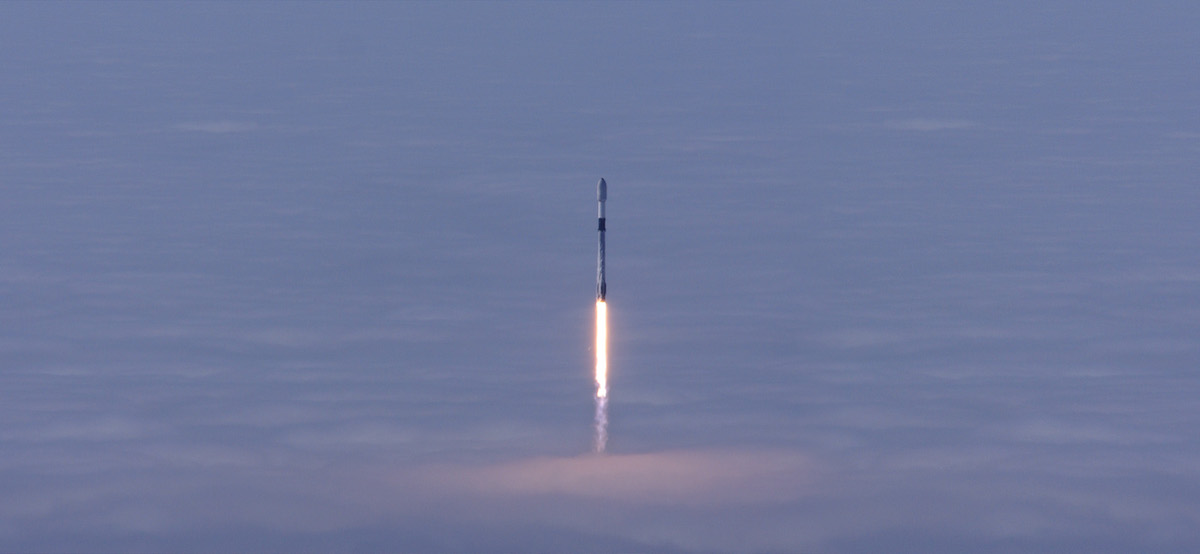Space News & Blog Articles
Starlink mission marks SpaceX’s second Falcon 9 launch in one day
 A Falcon 9 rocket climbs above a fog layer over Vandenberg Space Force Base, California, to begin the Starlink 4-29 mission. Credit: SpaceX
A Falcon 9 rocket climbs above a fog layer over Vandenberg Space Force Base, California, to begin the Starlink 4-29 mission. Credit: SpaceX
Seven hours after a Falcon 9 launcher carried a four-person crew into orbit from Florida, SpaceX sent aloft another Falcon 9 from a foggy California spaceport Wednesday evening with 52 more Starlink internet satellites, setting a new record for the shortest interval between two flights of SpaceX’s workhorse rocket.
The 229-foot-tall (70-meter) liquid-fueled launcher lifted off at 4:10:30 p.m. PDT (7:10:30 p.m. EDT; 2310:30 GMT) from Space Launch Complex 4-East at Vandenberg, located on California’s Central Coast about 140 miles (225 kilometers) northwest of Los Angeles.
The mission from Vandenberg, designated Starlink 4-29, was the 45th SpaceX launch of the year, and the second of three Falcon 9 missions on the company’s schedule this week. Another Falcon 9 rocket is being readied for liftoff Thursday evening at Cape Canaveral Space Force Station with two commercial TV broadcasting satellites for Intelsat.
Powered by nine kerosene-fueled main engines, the Starlink 4-29 mission headed southeast from Vandenberg on a trajectory over the Pacific Ocean, parallel to the coast of Southern California and Baja California.
The Falcon 9’s first stage booster, tail number B1071, detached from the upper stage about two-and-a-half minutes after liftoff to head for an offshore landing on SpaceX’s drone ship “Of Course I Still Love You” parked in the Pacific. The rocket landed on the drone ship less than nine minutes after launching, using propulsive braking burns to slow down and target the football field-size vessel.
The reusable booster stage completed its fifth flight, following a debut launch in February on the NROL-87 mission for the National Reconnaissance Office. The rocket flew again in April on the NRO’s NROL-85 mission, launched the German military’s SARah 1 radar reconnaissance satellite in June, then most recently flew July 22 on a Starlink mission. After landing Wednesday following the Starlink 4-29 launch, the booster will return to port in California for refurbishment and reuse.
All of the booster’s flights so far have launched from Vandenberg.
The Falcon 9’s upper stage continued Wednesday’s mission and ignited two times to inject the 52 Starlink satellites into a near-circular orbit at an average altitude of around 193 miles (311 kilometers), with an inclination angle of 53.2 degrees to the equator. The satellites deployed from the Falcon 9 around 62 minutes after liftoff, and SpaceX declared mission success.
Four retention rods jettisoned to allow the flat-packed Starlink satellites to fly free of the rocket.
After separating from the Falcon 9, the Starlink satellites were expected to disperse and extend solar panels to begin generating electricity to recharge their batteries. The satellites will go through an automated checkout and activation sequence, then use krypton-fueled ion thrusters to raise their altitude to 335 miles (540 kilometers), where they will enter operational service in the Starlink network.
The 52 new Starlink satellites launched into one of five orbital “shells” in SpaceX’s internet constellation.
After four Starlink launches from Vandenberg during the summer into Shell 3, one of the network’s two polar orbit shells, SpaceX targeted Shell 4 with Wendnesday’s mission. The network architecture includes satellites flying a few hundred miles up, orbiting at inclinations of 97.6 degrees, 70 degrees, 53.2 degrees, and 53.0 degrees to the equator. The spacecraft beam broadband internet signals to consumers around the world, connectivity that is now available on all seven continents.
SpaceX completed launches to the first Starlink shell, at 53.0 degrees inclination, last year. The company’s current focus is on deploying satellites into Shell 4 using a series of Falcon 9 rocket launches from Florida and California.
Three-quarters of SpaceX’s 45 missions so far in 2022 have been flights primarily dedicated to delivering Starlink satellites into orbit.
The launch from California Wednesday occurred 7 hours and 10 minutes after the Crew-5 mission departed from Kennedy Space Center, the shortest time between two Falcon 9 launches in SpaceX’s history.
Earlier this week, a SpaceX official said there’s no theoretical time limit on turnaround times between Falcon 9 flights from different launch pads. Chief engineers working on each Falcon 9 mission are responsible for reviewing data from previous flights to make sure there were no close calls or other issues that might impact future launches, according to Benji Reed, SpaceX’s senior director of human spaceflight programs.
NASA requires about two days to conduct a more extensive data review between a Falcon 9 launch for another customer and a crew launch to the International Space Station. That requirement forced SpaceX to wait to launch the Starlink 4-29 mission from Vandenberg hours after the Crew-5 launch, rather than the day before Crew-5.
The Starlink 4-29 mission was originally set for Monday, but SpaceX delayed the flight to allow more time for pre-launch checkouts, Reed said. SpaceX would have been ready to launch Starlink 4-29 on Tuesday, but the company gave priority to the NASA crew launch from Florida, causing the Starlink mission to slip another day to Wednesday.
This email address is being protected from spambots. You need JavaScript enabled to view it. the author.
Follow Stephen Clark on Twitter: @StephenClark1.
When you subscribe to the SpaceZE News Feed, we will send you an e-mail when there are new updates on the site so you wouldn't miss them.

